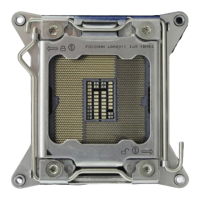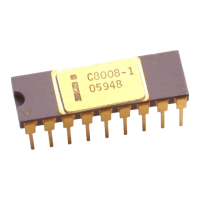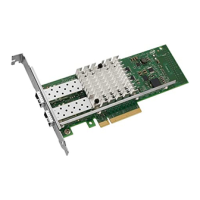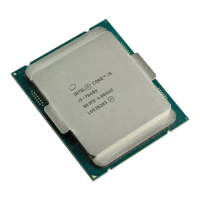Intel® Xeon™ Processor with 800 MHz System Bus
Datasheet 73
FORCEPR# can be used to thermally protect other system components. To use the VR as an
example, when the FORCEPR# pin is asserted, the TCC circuit in the processor will activate,
reducing the current consumption of the processor and the corresponding temperature of the VR.
If should be noted that assertion of the FORCEPR# does not automatically assert PROCHOT#. As
mentioned previously, the PROCHOT# signal is asserted when a high temperature situation is
detected. A minimum pulse width of 500 µs is recommend when the FORCEPR# is asserted by the
system. Sustained activation of the FORCEPR# pin may cause noticeable platform performance
degradation.
6.2.5 THERMTRIP# Signal Pin
Regardless of whether or not Thermal Monitor is enabled, in the event of a catastrophic cooling
failure, the processor will automatically shut down when the silicon has reached an elevated
temperature (refer to the THERMTRIP# definition in Table 20). At this point, the system bus
signal THERMTRIP# will go active and stay active as described in Table 20. THERMTRIP#
activation is independent of processor activity and does not generate any bus cycles.
6.2.6 T
CONTROL
and Fan Speed Reduction
Tcontrol is a temperature specification based on a temperature reading from the thermal diode. The
value for Tcontrol will be calibrated in manufacturing and configured for each processor. The
Tcontrol temperature for a given processor can be obtained by reading the IA-
32_TEMPERATURE_TARGET MSR in the processor. The Tcontrol value that is read from the
IA-32_TEMPERATURE_TARGET MSR must be converted from Hexadecimal to Decimal and
added to a base value. The base value is 50 °C.
The value of Tcontrol may vary from 0x00h to 0x1Eh. Systems that support the Intel® Xeon™
processor with 800 MHz system bus must implement BIOS changes to detect which processor is
present, and then select the appropriate Tcontrol_base value.
When Tdiode is above Tcontrol, then T
CASE
must be at or below T
CASE_MAX
as defined by the
thermal profile. (For Intel® Xeon™ processor with 800 MHz system bus see Figure 13; Table 24
and Table 25. Otherwise, the processor temperature can be maintained at Tcontrol.)
6.2.7 Thermal Diode
The processor incorporates an on-die thermal diode. A thermal sensor located on the system board
may monitor the die temperature of the processor for thermal management/long term die
temperature change purposes. Table 26 and Table 27 provide the diode parameter and interface
specifications. This thermal diode is separate from the Thermal Monitor’s thermal sensor and
cannot be used to predict the behavior of the Thermal Monitor.
NOTES:
1. Intel does not support or recommend operation of the thermal diode under reverse bias.
2. Characterized at 75°C.
Table 26. Thermal Diode Parameters
Symbol Symbol Min Typ Max Unit Notes
I
FW
Forward Bias Current 11 187 µA 1
n Diode ideality factor 1.0083 1.011 1.0183 2,3,4
R
T
Series Resistance 3.242 3.33 3.594 W 2,3,5
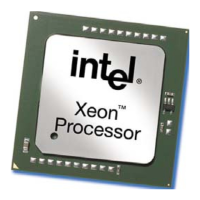
